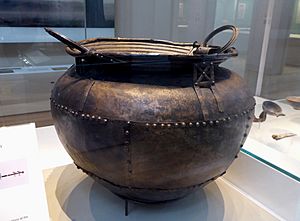Battersea Cauldron facts for kids
The Battersea Cauldron is a very old and large bronze pot. It was used for cooking or holding drinks. Experts believe it was made between 800 BC and 700 BC. That's about 2,700 to 2,800 years ago!
This special pot was found in 1861. It was discovered in the River Thames in London, near a new bridge called Chelsea Bridge. This bridge connects the areas of Chelsea and Battersea. Soon after it was found, the British Museum bought it. The Battersea Cauldron is one of over 60 similar large pots from the Late Bronze Age and Iron Age found in Great Britain and Ireland.
Contents
What is the Battersea Cauldron?
The cauldron stands about 40.5 centimeters (16 inches) tall. It is 56 centimeters (22 inches) wide across the top. It could hold about 70 liters (18.5 gallons) of liquid. Imagine how much soup or drink that is!
The pot was made from seven curved pieces of bronze. These pieces were joined together with rivets. This created a large, round cooking pot with a narrower top. The opening of the pot flares out. It has special ridges around the rim to make it stronger. Two ring-shaped handles are attached to the pot with bronze straps.
How was it used?
Because it's so big, the Battersea Cauldron was likely used for large gatherings. People might have used it for big feasts or celebrations. It shows signs of being used for a long time, maybe even for many generations. It has patches and repairs from its long life.
Some experts believe the cauldron was placed in the river on purpose. It might have been a special gift or offering to gods or spirits. This was a common practice in ancient times.
Similar Cauldrons from Around the World
Large bronze cauldrons like this have been found in other places too. Archaeologists have found similar pots in Greece. This suggests there might have been cultural connections between ancient Britain and Greece.
Similar bronze cauldrons from the Atlantic Bronze Age have also been found in Iberia (modern-day Spain and Portugal). Large bronze cauldrons were also important in the Hallstatt culture during the Iron Age. This culture was found in parts of Germany and France. For example, a cauldron from Greece was found in a special burial site in Germany called the Hochdorf Chieftain's Grave. This cauldron was filled with mead, a type of honey drink, and had a gold serving bowl inside.
Gallery
See also
- Bronze Age Britain
- British Iron Age
- The Battersea Shield, another famous ancient object found nearby a few years earlier.
- A group of 17 cauldrons found at Chiseldon in Wiltshire in 2004-2005. They are dated to around 300 BC.




